Management Accounting and Financial Analysis: A Samsung Case Study
VerifiedAdded on 2024/04/26
|23
|4023
|447
Report
AI Summary
This management accounting report provides a comprehensive analysis of Samsung's financial strategies and systems. It begins with an overview of management accounting, detailing its essential requirements and reporting methods. The report then delves into cost analysis, comparing absorption and marginal costing methods to prepare income statements and understand their differences. Furthermore, it explores various planning tools for budgetary control, evaluating their advantages and disadvantages. Finally, the report benchmarks Samsung against a competitor to assess how organizations adapt management accounting systems to address financial challenges, offering valuable insights into practical applications of management accounting principles. Desklib provides access to this and other solved assignments for students.
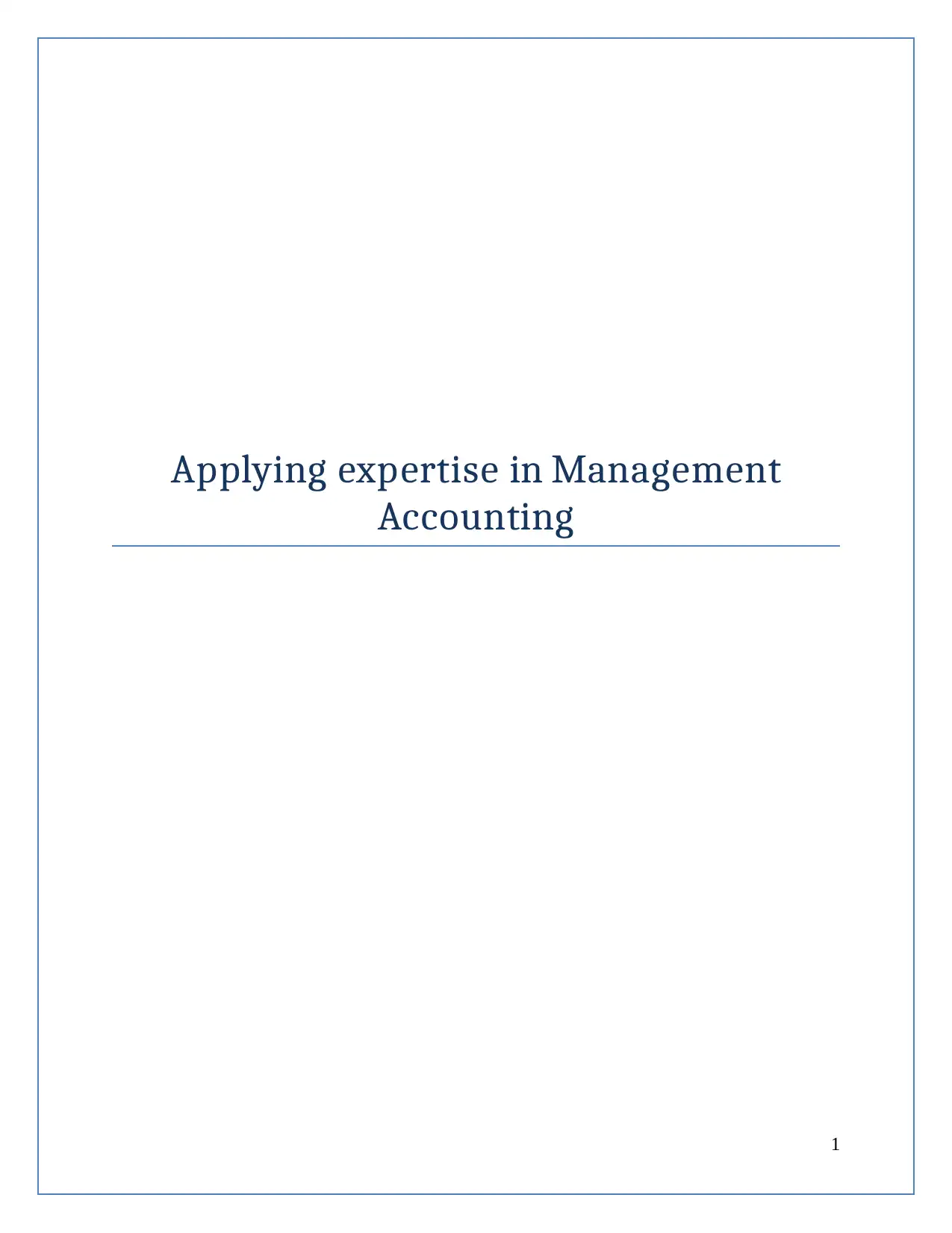
Applying expertise in Management
Accounting
1
Accounting
1
Paraphrase This Document
Need a fresh take? Get an instant paraphrase of this document with our AI Paraphraser
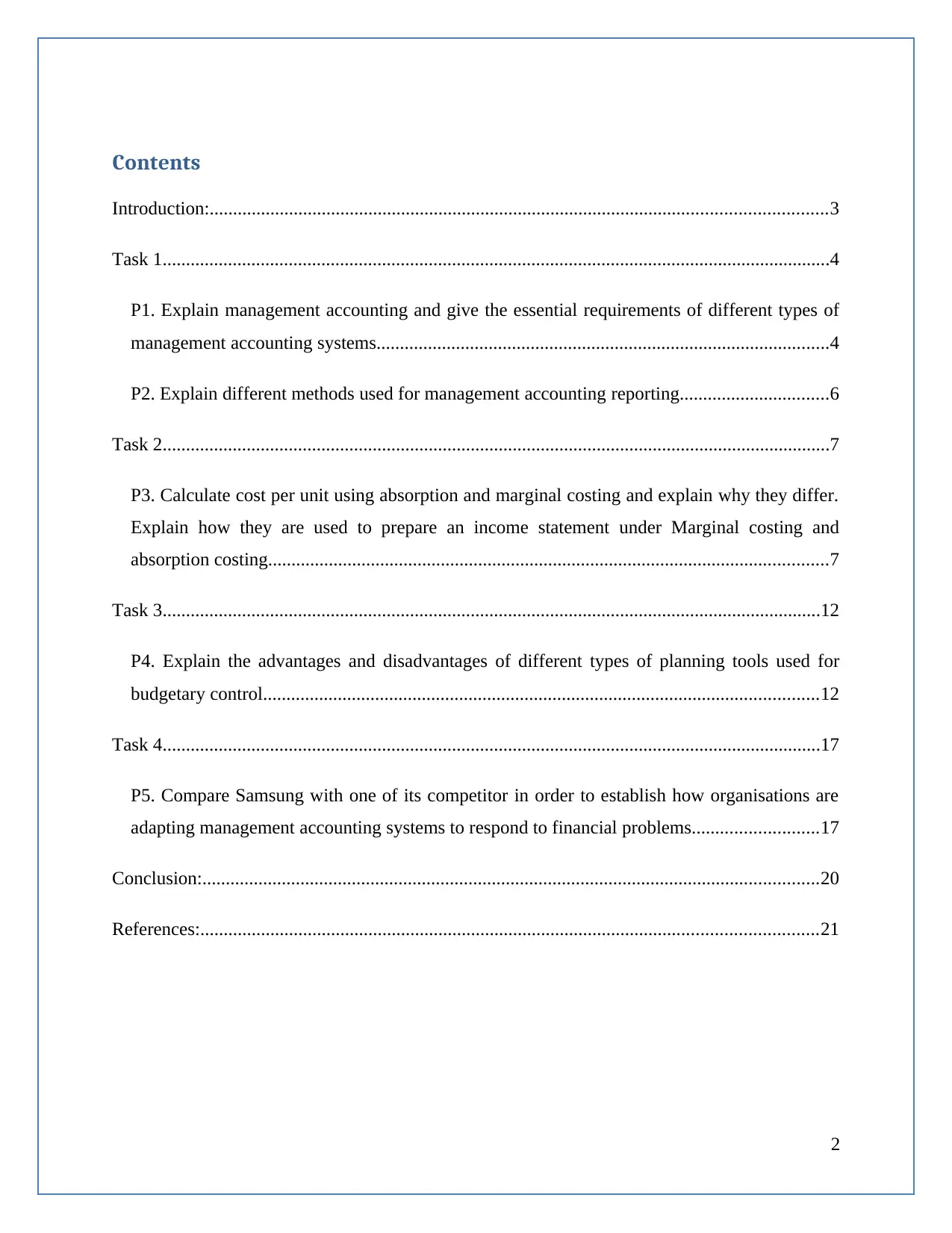
Contents
Introduction:....................................................................................................................................3
Task 1...............................................................................................................................................4
P1. Explain management accounting and give the essential requirements of different types of
management accounting systems.................................................................................................4
P2. Explain different methods used for management accounting reporting................................6
Task 2...............................................................................................................................................7
P3. Calculate cost per unit using absorption and marginal costing and explain why they differ.
Explain how they are used to prepare an income statement under Marginal costing and
absorption costing........................................................................................................................7
Task 3.............................................................................................................................................12
P4. Explain the advantages and disadvantages of different types of planning tools used for
budgetary control.......................................................................................................................12
Task 4.............................................................................................................................................17
P5. Compare Samsung with one of its competitor in order to establish how organisations are
adapting management accounting systems to respond to financial problems...........................17
Conclusion:....................................................................................................................................20
References:....................................................................................................................................21
2
Introduction:....................................................................................................................................3
Task 1...............................................................................................................................................4
P1. Explain management accounting and give the essential requirements of different types of
management accounting systems.................................................................................................4
P2. Explain different methods used for management accounting reporting................................6
Task 2...............................................................................................................................................7
P3. Calculate cost per unit using absorption and marginal costing and explain why they differ.
Explain how they are used to prepare an income statement under Marginal costing and
absorption costing........................................................................................................................7
Task 3.............................................................................................................................................12
P4. Explain the advantages and disadvantages of different types of planning tools used for
budgetary control.......................................................................................................................12
Task 4.............................................................................................................................................17
P5. Compare Samsung with one of its competitor in order to establish how organisations are
adapting management accounting systems to respond to financial problems...........................17
Conclusion:....................................................................................................................................20
References:....................................................................................................................................21
2
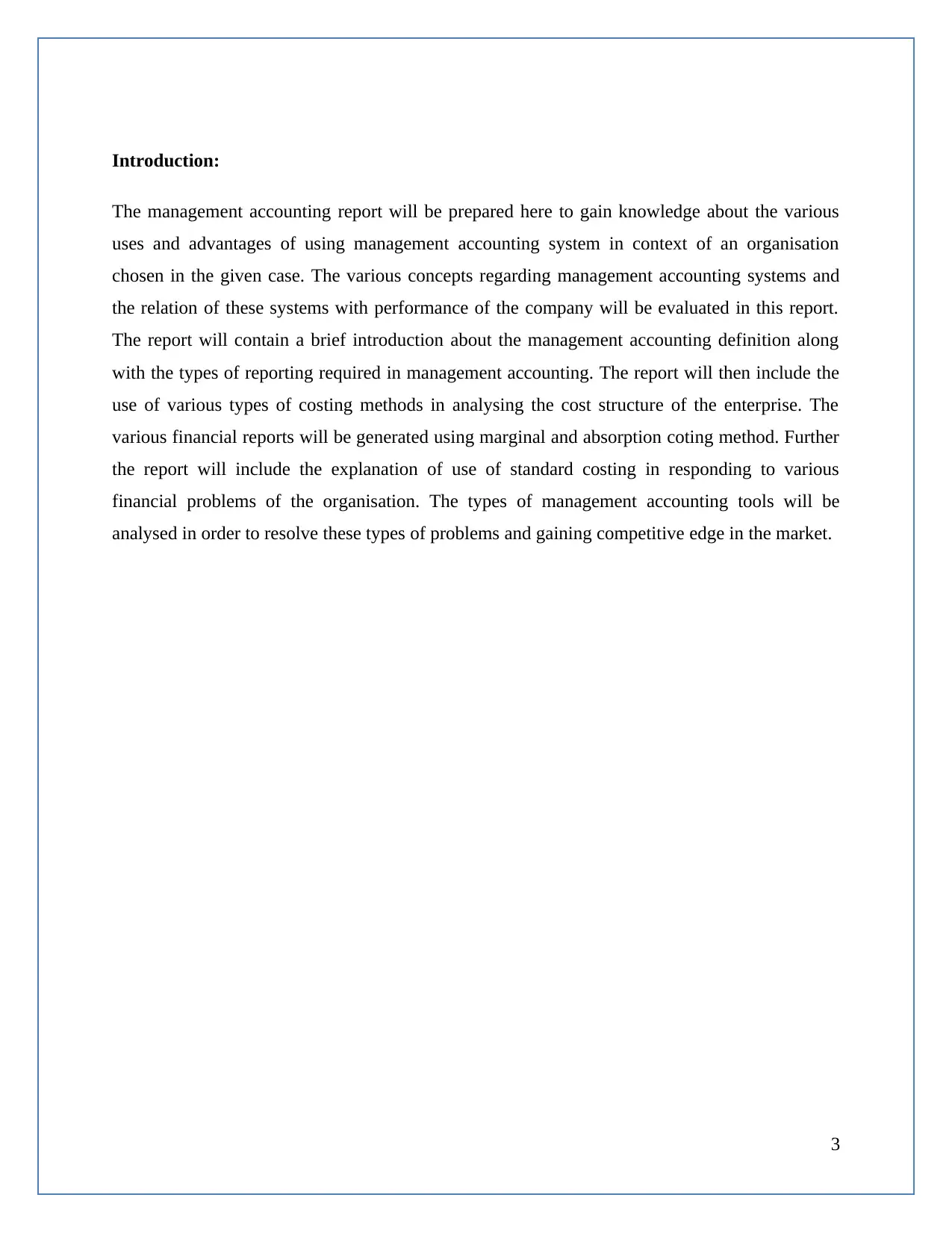
Introduction:
The management accounting report will be prepared here to gain knowledge about the various
uses and advantages of using management accounting system in context of an organisation
chosen in the given case. The various concepts regarding management accounting systems and
the relation of these systems with performance of the company will be evaluated in this report.
The report will contain a brief introduction about the management accounting definition along
with the types of reporting required in management accounting. The report will then include the
use of various types of costing methods in analysing the cost structure of the enterprise. The
various financial reports will be generated using marginal and absorption coting method. Further
the report will include the explanation of use of standard costing in responding to various
financial problems of the organisation. The types of management accounting tools will be
analysed in order to resolve these types of problems and gaining competitive edge in the market.
3
The management accounting report will be prepared here to gain knowledge about the various
uses and advantages of using management accounting system in context of an organisation
chosen in the given case. The various concepts regarding management accounting systems and
the relation of these systems with performance of the company will be evaluated in this report.
The report will contain a brief introduction about the management accounting definition along
with the types of reporting required in management accounting. The report will then include the
use of various types of costing methods in analysing the cost structure of the enterprise. The
various financial reports will be generated using marginal and absorption coting method. Further
the report will include the explanation of use of standard costing in responding to various
financial problems of the organisation. The types of management accounting tools will be
analysed in order to resolve these types of problems and gaining competitive edge in the market.
3
⊘ This is a preview!⊘
Do you want full access?
Subscribe today to unlock all pages.

Trusted by 1+ million students worldwide
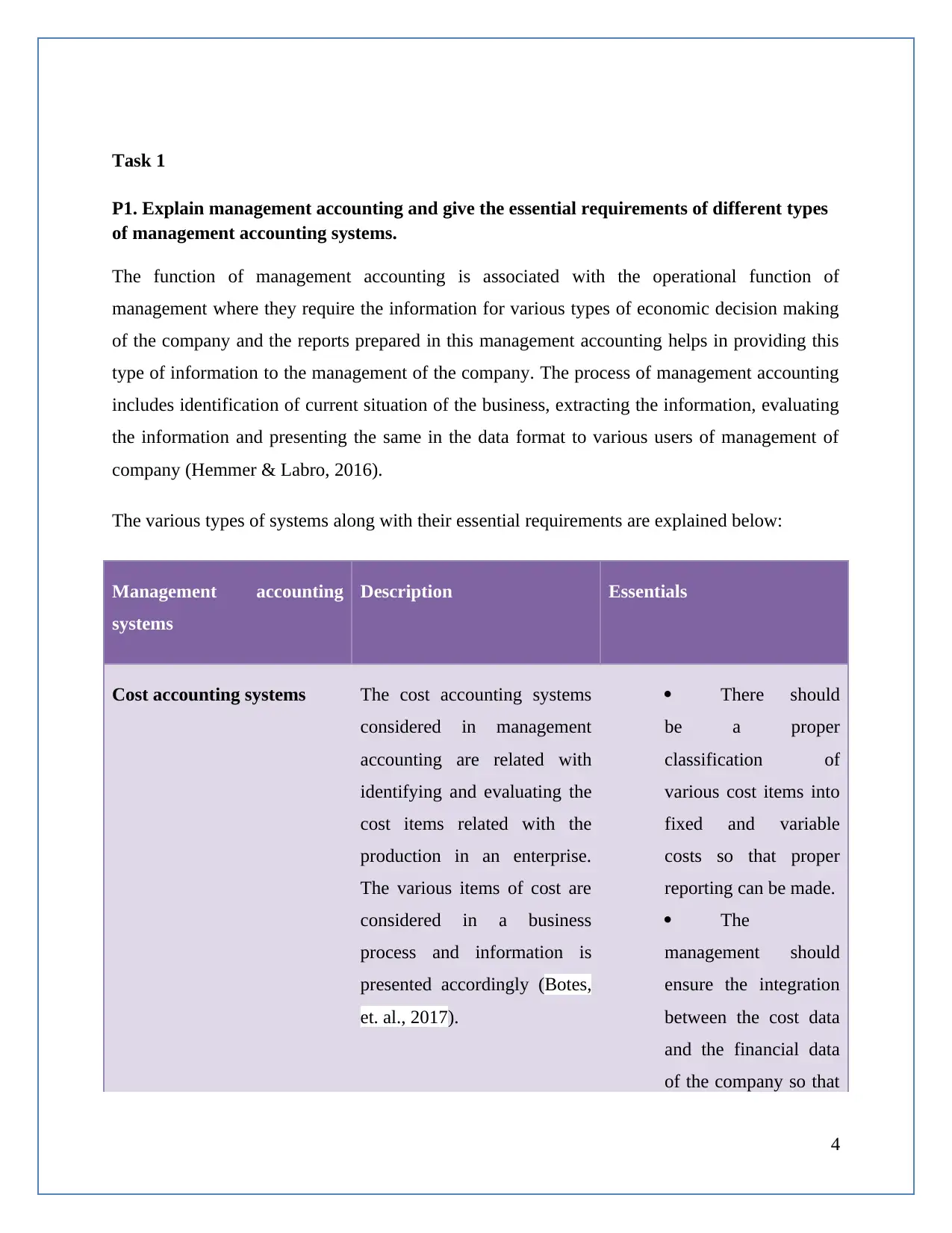
Task 1
P1. Explain management accounting and give the essential requirements of different types
of management accounting systems.
The function of management accounting is associated with the operational function of
management where they require the information for various types of economic decision making
of the company and the reports prepared in this management accounting helps in providing this
type of information to the management of the company. The process of management accounting
includes identification of current situation of the business, extracting the information, evaluating
the information and presenting the same in the data format to various users of management of
company (Hemmer & Labro, 2016).
The various types of systems along with their essential requirements are explained below:
Management accounting
systems
Description Essentials
Cost accounting systems The cost accounting systems
considered in management
accounting are related with
identifying and evaluating the
cost items related with the
production in an enterprise.
The various items of cost are
considered in a business
process and information is
presented accordingly (Botes,
et. al., 2017).
There should
be a proper
classification of
various cost items into
fixed and variable
costs so that proper
reporting can be made.
The
management should
ensure the integration
between the cost data
and the financial data
of the company so that
4
P1. Explain management accounting and give the essential requirements of different types
of management accounting systems.
The function of management accounting is associated with the operational function of
management where they require the information for various types of economic decision making
of the company and the reports prepared in this management accounting helps in providing this
type of information to the management of the company. The process of management accounting
includes identification of current situation of the business, extracting the information, evaluating
the information and presenting the same in the data format to various users of management of
company (Hemmer & Labro, 2016).
The various types of systems along with their essential requirements are explained below:
Management accounting
systems
Description Essentials
Cost accounting systems The cost accounting systems
considered in management
accounting are related with
identifying and evaluating the
cost items related with the
production in an enterprise.
The various items of cost are
considered in a business
process and information is
presented accordingly (Botes,
et. al., 2017).
There should
be a proper
classification of
various cost items into
fixed and variable
costs so that proper
reporting can be made.
The
management should
ensure the integration
between the cost data
and the financial data
of the company so that
4
Paraphrase This Document
Need a fresh take? Get an instant paraphrase of this document with our AI Paraphraser
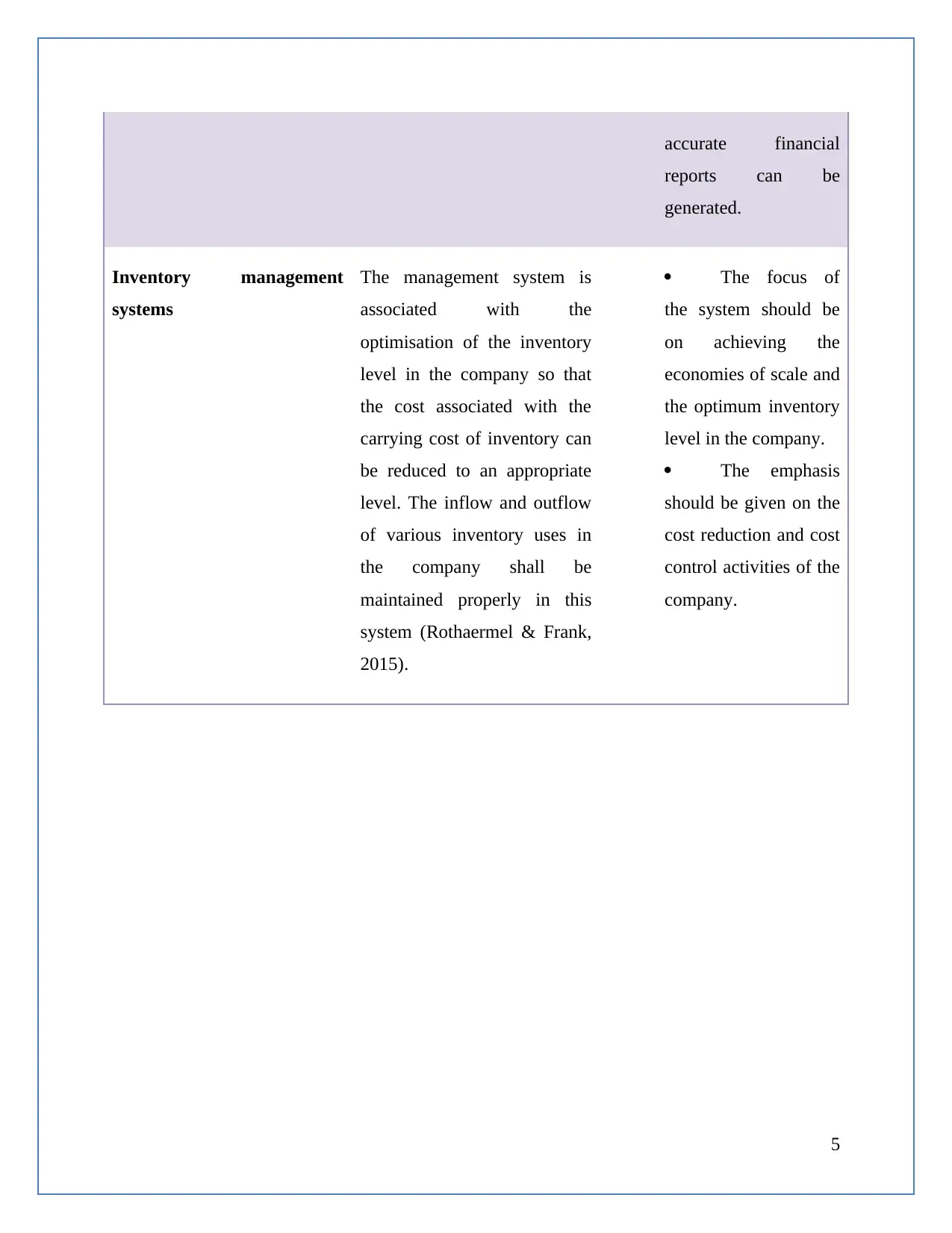
accurate financial
reports can be
generated.
Inventory management
systems
The management system is
associated with the
optimisation of the inventory
level in the company so that
the cost associated with the
carrying cost of inventory can
be reduced to an appropriate
level. The inflow and outflow
of various inventory uses in
the company shall be
maintained properly in this
system (Rothaermel & Frank,
2015).
The focus of
the system should be
on achieving the
economies of scale and
the optimum inventory
level in the company.
The emphasis
should be given on the
cost reduction and cost
control activities of the
company.
5
reports can be
generated.
Inventory management
systems
The management system is
associated with the
optimisation of the inventory
level in the company so that
the cost associated with the
carrying cost of inventory can
be reduced to an appropriate
level. The inflow and outflow
of various inventory uses in
the company shall be
maintained properly in this
system (Rothaermel & Frank,
2015).
The focus of
the system should be
on achieving the
economies of scale and
the optimum inventory
level in the company.
The emphasis
should be given on the
cost reduction and cost
control activities of the
company.
5
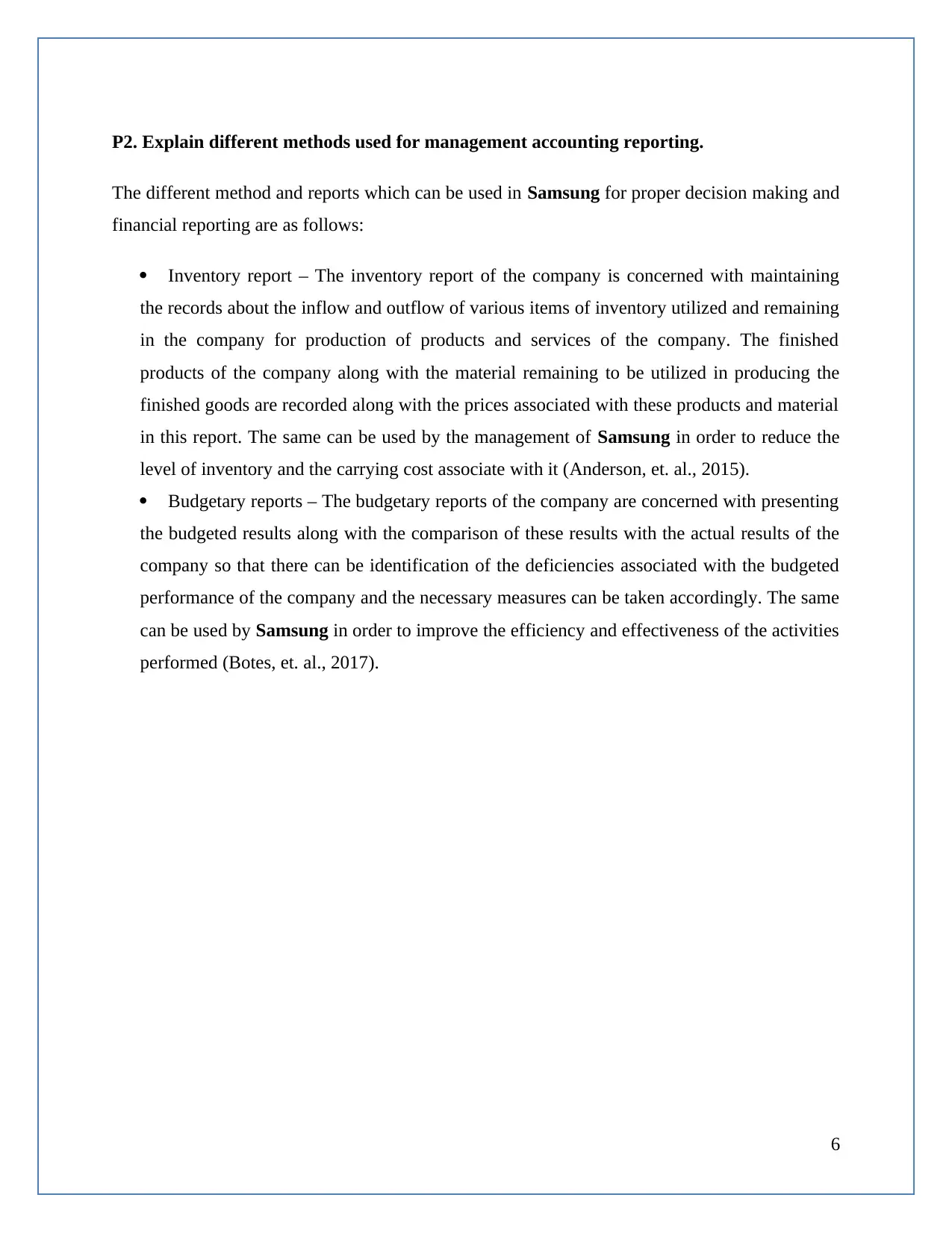
P2. Explain different methods used for management accounting reporting.
The different method and reports which can be used in Samsung for proper decision making and
financial reporting are as follows:
Inventory report – The inventory report of the company is concerned with maintaining
the records about the inflow and outflow of various items of inventory utilized and remaining
in the company for production of products and services of the company. The finished
products of the company along with the material remaining to be utilized in producing the
finished goods are recorded along with the prices associated with these products and material
in this report. The same can be used by the management of Samsung in order to reduce the
level of inventory and the carrying cost associate with it (Anderson, et. al., 2015).
Budgetary reports – The budgetary reports of the company are concerned with presenting
the budgeted results along with the comparison of these results with the actual results of the
company so that there can be identification of the deficiencies associated with the budgeted
performance of the company and the necessary measures can be taken accordingly. The same
can be used by Samsung in order to improve the efficiency and effectiveness of the activities
performed (Botes, et. al., 2017).
6
The different method and reports which can be used in Samsung for proper decision making and
financial reporting are as follows:
Inventory report – The inventory report of the company is concerned with maintaining
the records about the inflow and outflow of various items of inventory utilized and remaining
in the company for production of products and services of the company. The finished
products of the company along with the material remaining to be utilized in producing the
finished goods are recorded along with the prices associated with these products and material
in this report. The same can be used by the management of Samsung in order to reduce the
level of inventory and the carrying cost associate with it (Anderson, et. al., 2015).
Budgetary reports – The budgetary reports of the company are concerned with presenting
the budgeted results along with the comparison of these results with the actual results of the
company so that there can be identification of the deficiencies associated with the budgeted
performance of the company and the necessary measures can be taken accordingly. The same
can be used by Samsung in order to improve the efficiency and effectiveness of the activities
performed (Botes, et. al., 2017).
6
⊘ This is a preview!⊘
Do you want full access?
Subscribe today to unlock all pages.

Trusted by 1+ million students worldwide
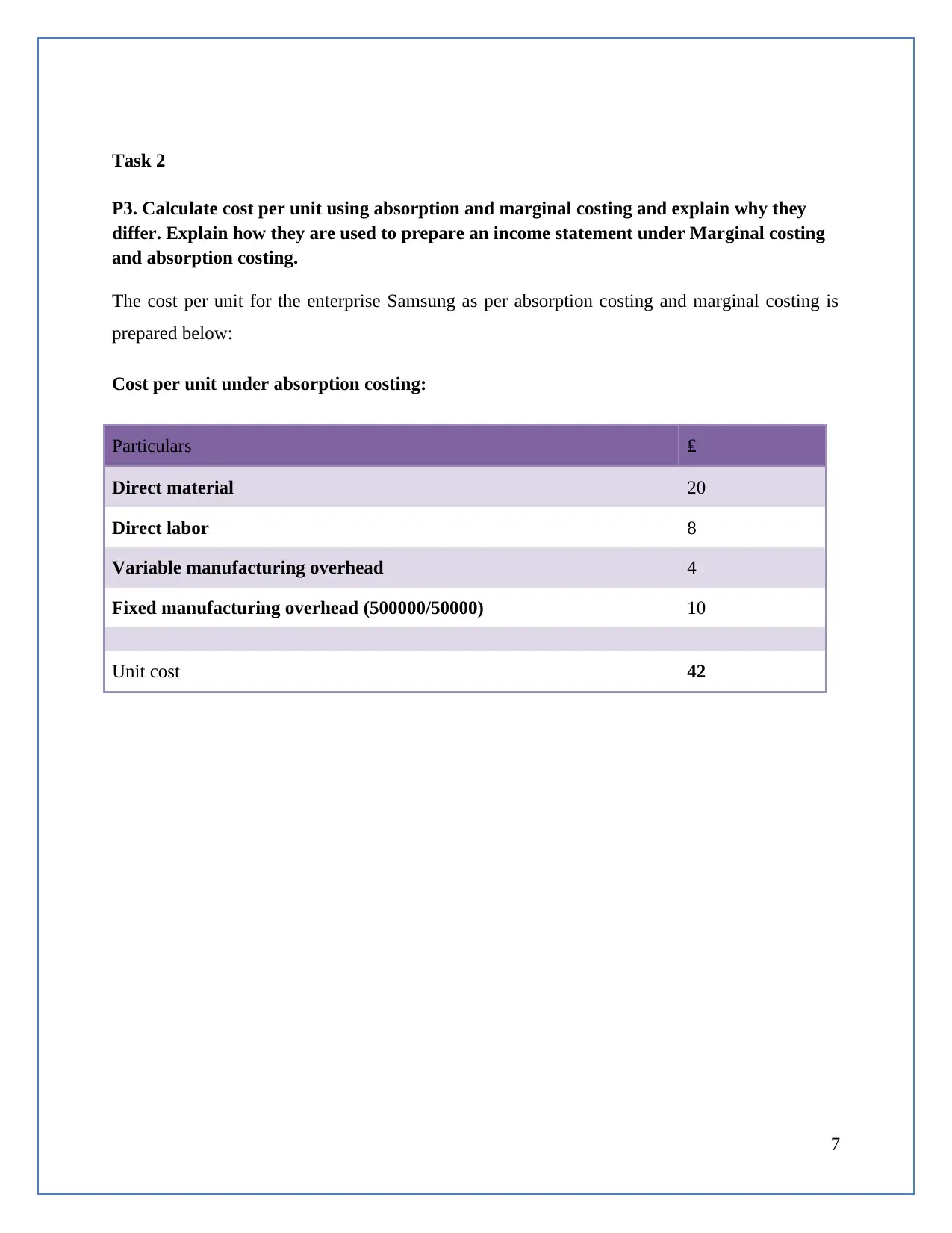
Task 2
P3. Calculate cost per unit using absorption and marginal costing and explain why they
differ. Explain how they are used to prepare an income statement under Marginal costing
and absorption costing.
The cost per unit for the enterprise Samsung as per absorption costing and marginal costing is
prepared below:
Cost per unit under absorption costing:
Particulars ₤
Direct material 20
Direct labor 8
Variable manufacturing overhead 4
Fixed manufacturing overhead (500000/50000) 10
Unit cost 42
7
P3. Calculate cost per unit using absorption and marginal costing and explain why they
differ. Explain how they are used to prepare an income statement under Marginal costing
and absorption costing.
The cost per unit for the enterprise Samsung as per absorption costing and marginal costing is
prepared below:
Cost per unit under absorption costing:
Particulars ₤
Direct material 20
Direct labor 8
Variable manufacturing overhead 4
Fixed manufacturing overhead (500000/50000) 10
Unit cost 42
7
Paraphrase This Document
Need a fresh take? Get an instant paraphrase of this document with our AI Paraphraser
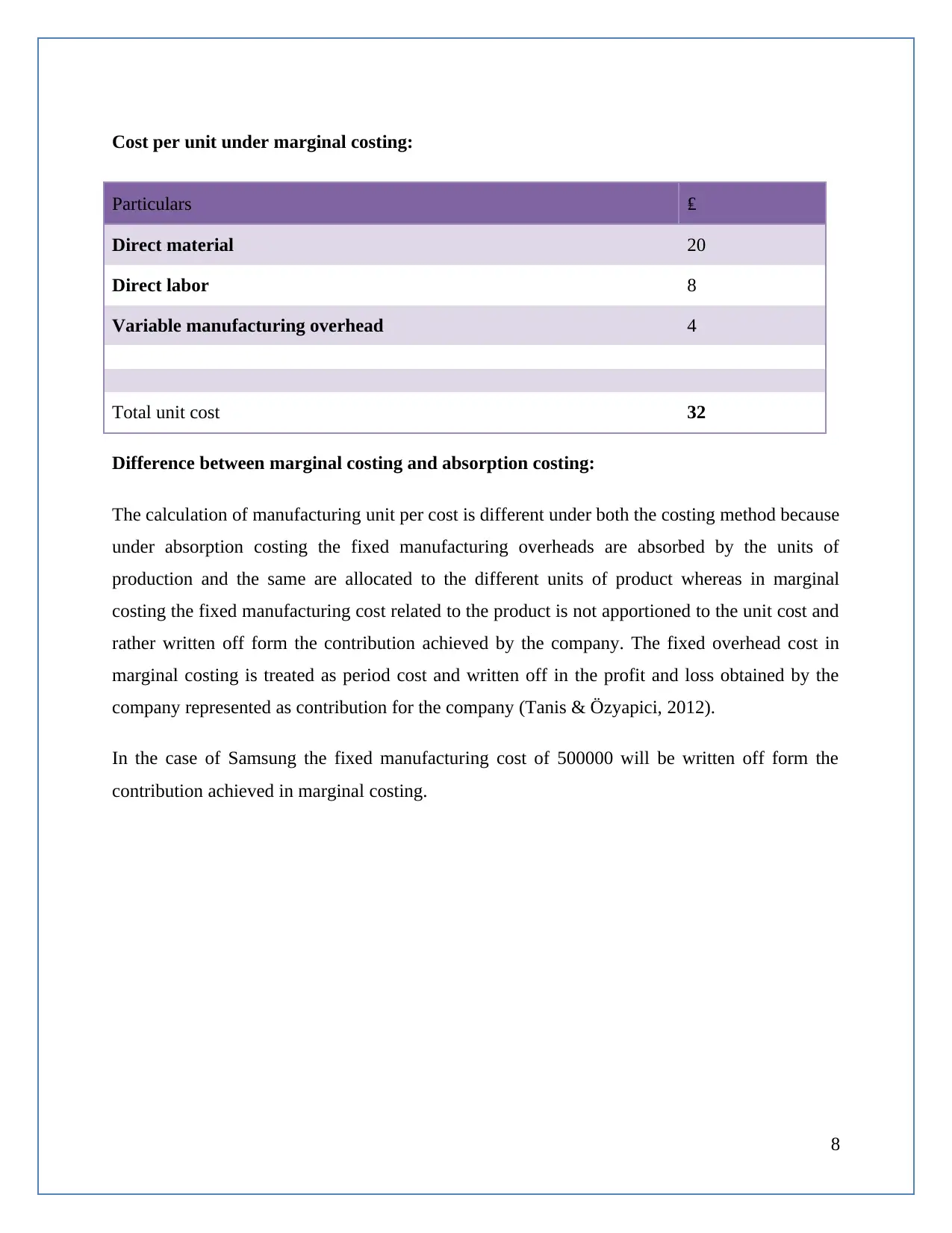
Cost per unit under marginal costing:
Particulars ₤
Direct material 20
Direct labor 8
Variable manufacturing overhead 4
Total unit cost 32
Difference between marginal costing and absorption costing:
The calculation of manufacturing unit per cost is different under both the costing method because
under absorption costing the fixed manufacturing overheads are absorbed by the units of
production and the same are allocated to the different units of product whereas in marginal
costing the fixed manufacturing cost related to the product is not apportioned to the unit cost and
rather written off form the contribution achieved by the company. The fixed overhead cost in
marginal costing is treated as period cost and written off in the profit and loss obtained by the
company represented as contribution for the company (Tanis & Özyapici, 2012).
In the case of Samsung the fixed manufacturing cost of 500000 will be written off form the
contribution achieved in marginal costing.
8
Particulars ₤
Direct material 20
Direct labor 8
Variable manufacturing overhead 4
Total unit cost 32
Difference between marginal costing and absorption costing:
The calculation of manufacturing unit per cost is different under both the costing method because
under absorption costing the fixed manufacturing overheads are absorbed by the units of
production and the same are allocated to the different units of product whereas in marginal
costing the fixed manufacturing cost related to the product is not apportioned to the unit cost and
rather written off form the contribution achieved by the company. The fixed overhead cost in
marginal costing is treated as period cost and written off in the profit and loss obtained by the
company represented as contribution for the company (Tanis & Özyapici, 2012).
In the case of Samsung the fixed manufacturing cost of 500000 will be written off form the
contribution achieved in marginal costing.
8
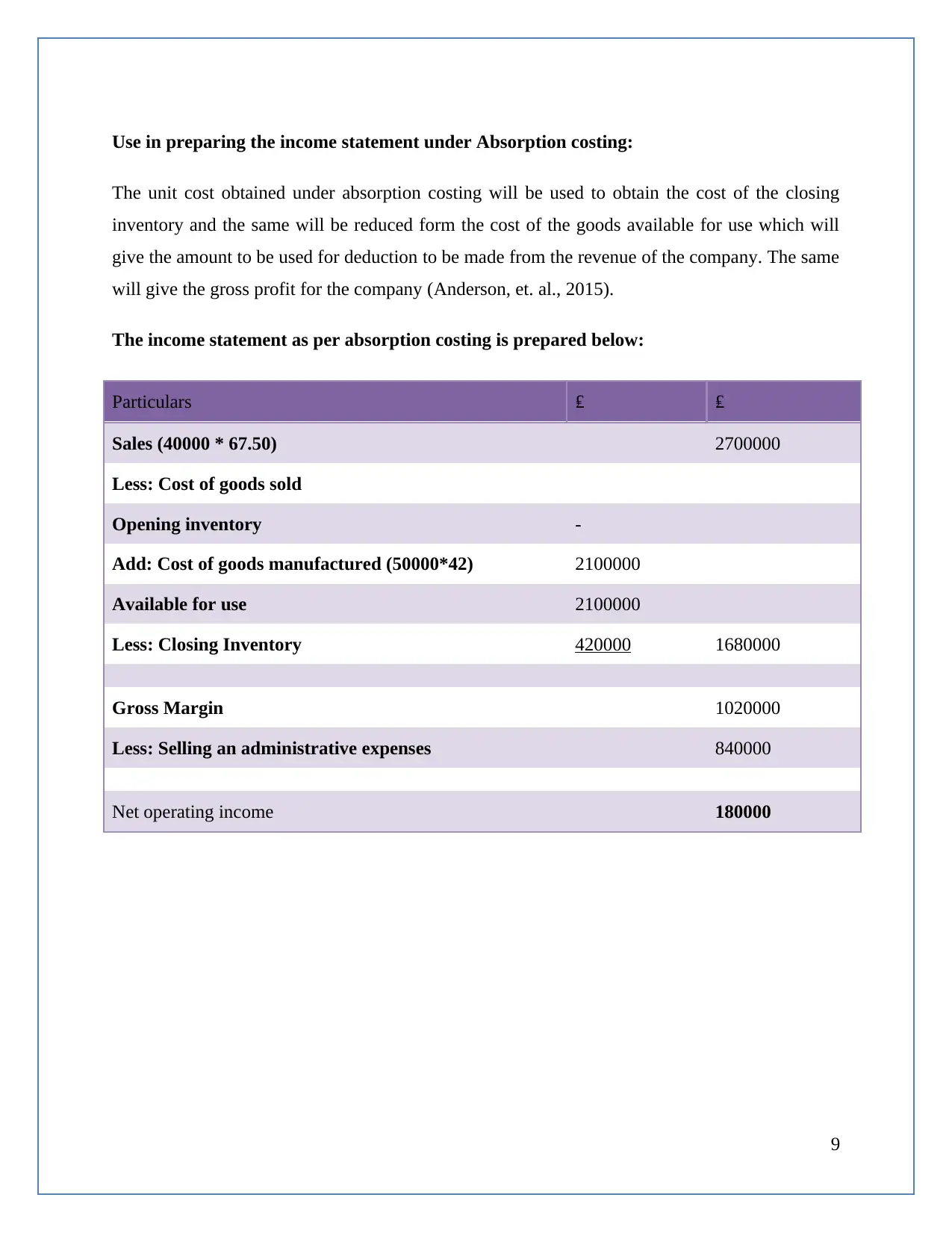
Use in preparing the income statement under Absorption costing:
The unit cost obtained under absorption costing will be used to obtain the cost of the closing
inventory and the same will be reduced form the cost of the goods available for use which will
give the amount to be used for deduction to be made from the revenue of the company. The same
will give the gross profit for the company (Anderson, et. al., 2015).
The income statement as per absorption costing is prepared below:
Particulars ₤ ₤
Sales (40000 * 67.50) 2700000
Less: Cost of goods sold
Opening inventory -
Add: Cost of goods manufactured (50000*42) 2100000
Available for use 2100000
Less: Closing Inventory 420000 1680000
Gross Margin 1020000
Less: Selling an administrative expenses 840000
Net operating income 180000
9
The unit cost obtained under absorption costing will be used to obtain the cost of the closing
inventory and the same will be reduced form the cost of the goods available for use which will
give the amount to be used for deduction to be made from the revenue of the company. The same
will give the gross profit for the company (Anderson, et. al., 2015).
The income statement as per absorption costing is prepared below:
Particulars ₤ ₤
Sales (40000 * 67.50) 2700000
Less: Cost of goods sold
Opening inventory -
Add: Cost of goods manufactured (50000*42) 2100000
Available for use 2100000
Less: Closing Inventory 420000 1680000
Gross Margin 1020000
Less: Selling an administrative expenses 840000
Net operating income 180000
9
⊘ This is a preview!⊘
Do you want full access?
Subscribe today to unlock all pages.

Trusted by 1+ million students worldwide
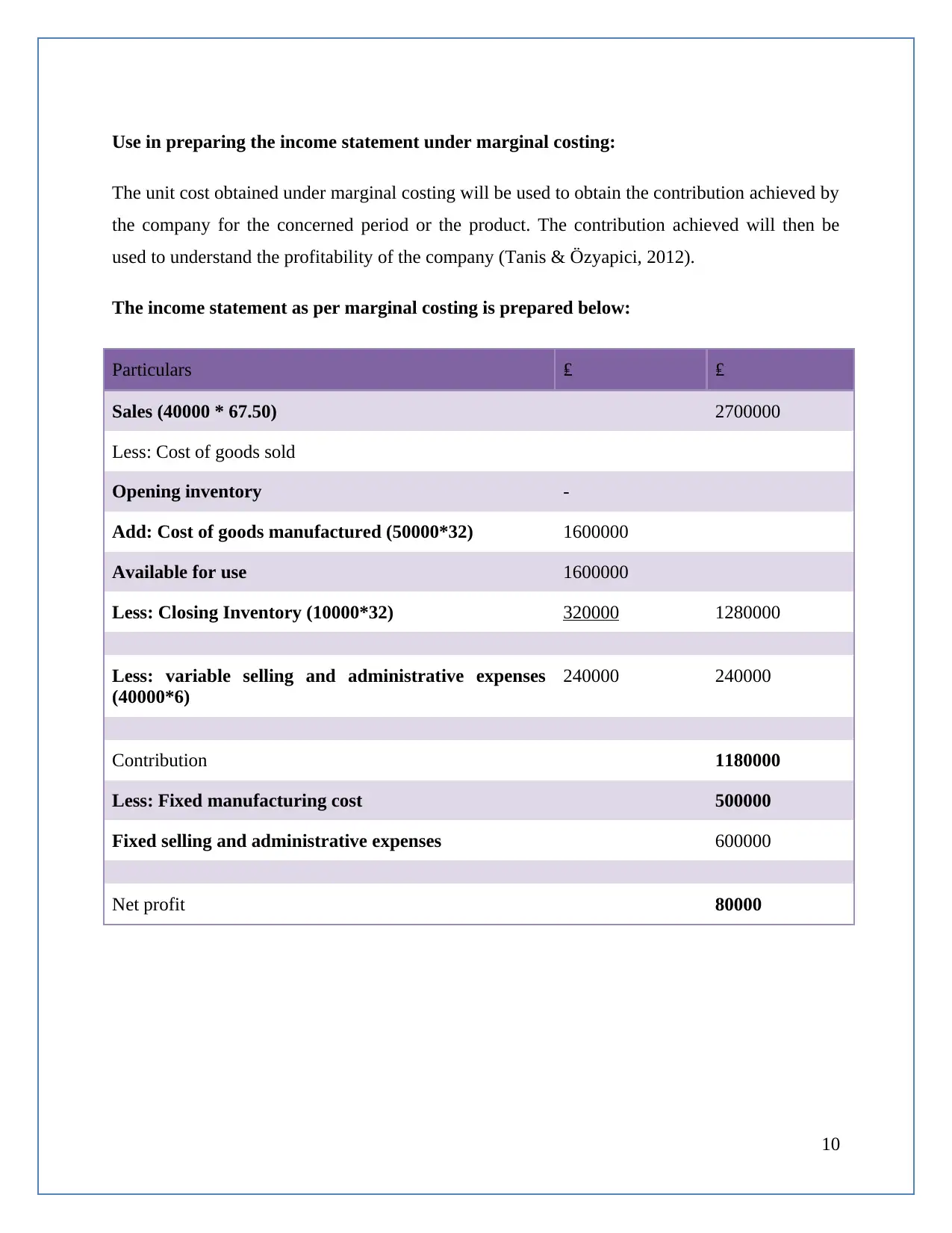
Use in preparing the income statement under marginal costing:
The unit cost obtained under marginal costing will be used to obtain the contribution achieved by
the company for the concerned period or the product. The contribution achieved will then be
used to understand the profitability of the company (Tanis & Özyapici, 2012).
The income statement as per marginal costing is prepared below:
Particulars ₤ ₤
Sales (40000 * 67.50) 2700000
Less: Cost of goods sold
Opening inventory -
Add: Cost of goods manufactured (50000*32) 1600000
Available for use 1600000
Less: Closing Inventory (10000*32) 320000 1280000
Less: variable selling and administrative expenses
(40000*6)
240000 240000
Contribution 1180000
Less: Fixed manufacturing cost 500000
Fixed selling and administrative expenses 600000
Net profit 80000
10
The unit cost obtained under marginal costing will be used to obtain the contribution achieved by
the company for the concerned period or the product. The contribution achieved will then be
used to understand the profitability of the company (Tanis & Özyapici, 2012).
The income statement as per marginal costing is prepared below:
Particulars ₤ ₤
Sales (40000 * 67.50) 2700000
Less: Cost of goods sold
Opening inventory -
Add: Cost of goods manufactured (50000*32) 1600000
Available for use 1600000
Less: Closing Inventory (10000*32) 320000 1280000
Less: variable selling and administrative expenses
(40000*6)
240000 240000
Contribution 1180000
Less: Fixed manufacturing cost 500000
Fixed selling and administrative expenses 600000
Net profit 80000
10
Paraphrase This Document
Need a fresh take? Get an instant paraphrase of this document with our AI Paraphraser
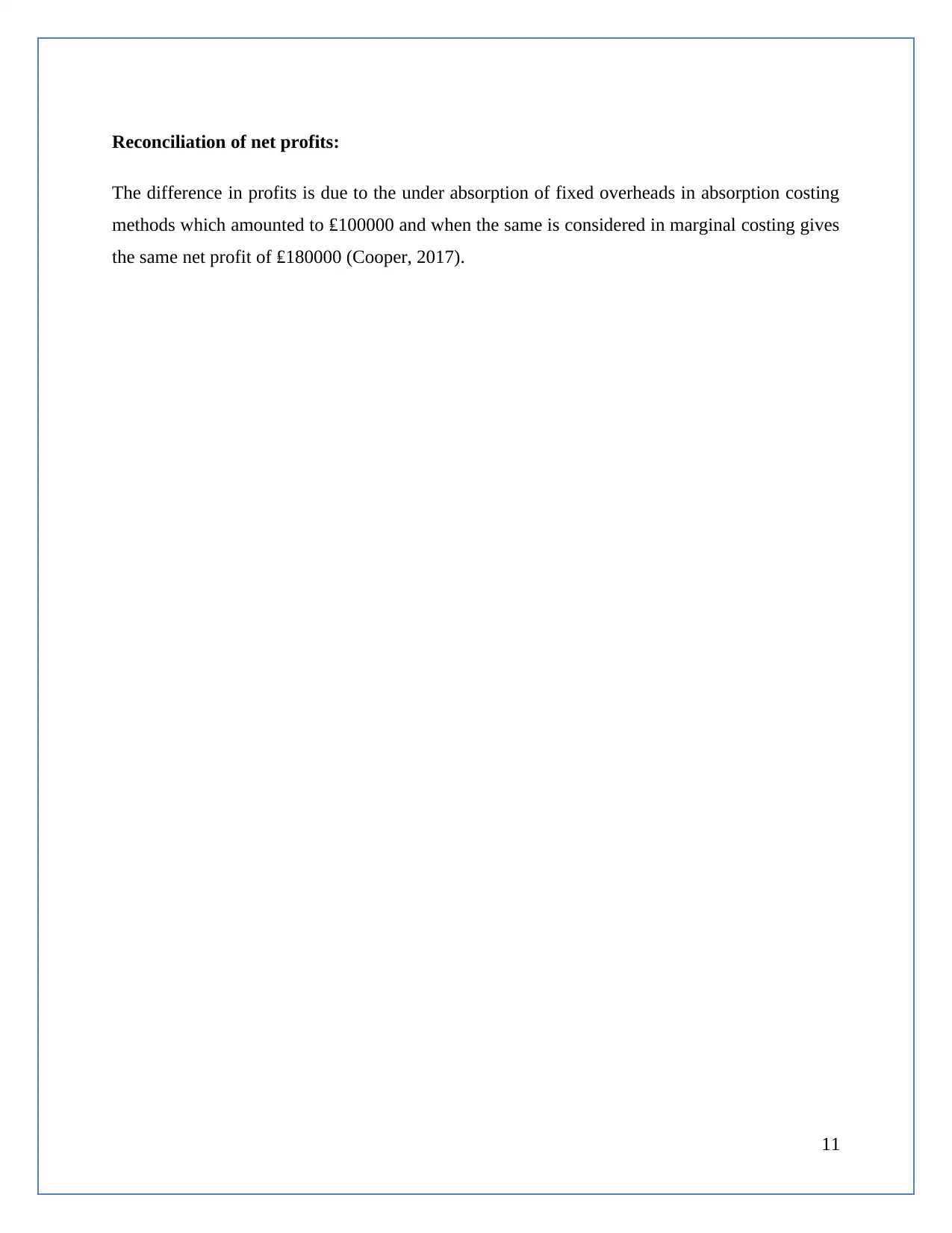
Reconciliation of net profits:
The difference in profits is due to the under absorption of fixed overheads in absorption costing
methods which amounted to ₤100000 and when the same is considered in marginal costing gives
the same net profit of ₤180000 (Cooper, 2017).
11
The difference in profits is due to the under absorption of fixed overheads in absorption costing
methods which amounted to ₤100000 and when the same is considered in marginal costing gives
the same net profit of ₤180000 (Cooper, 2017).
11
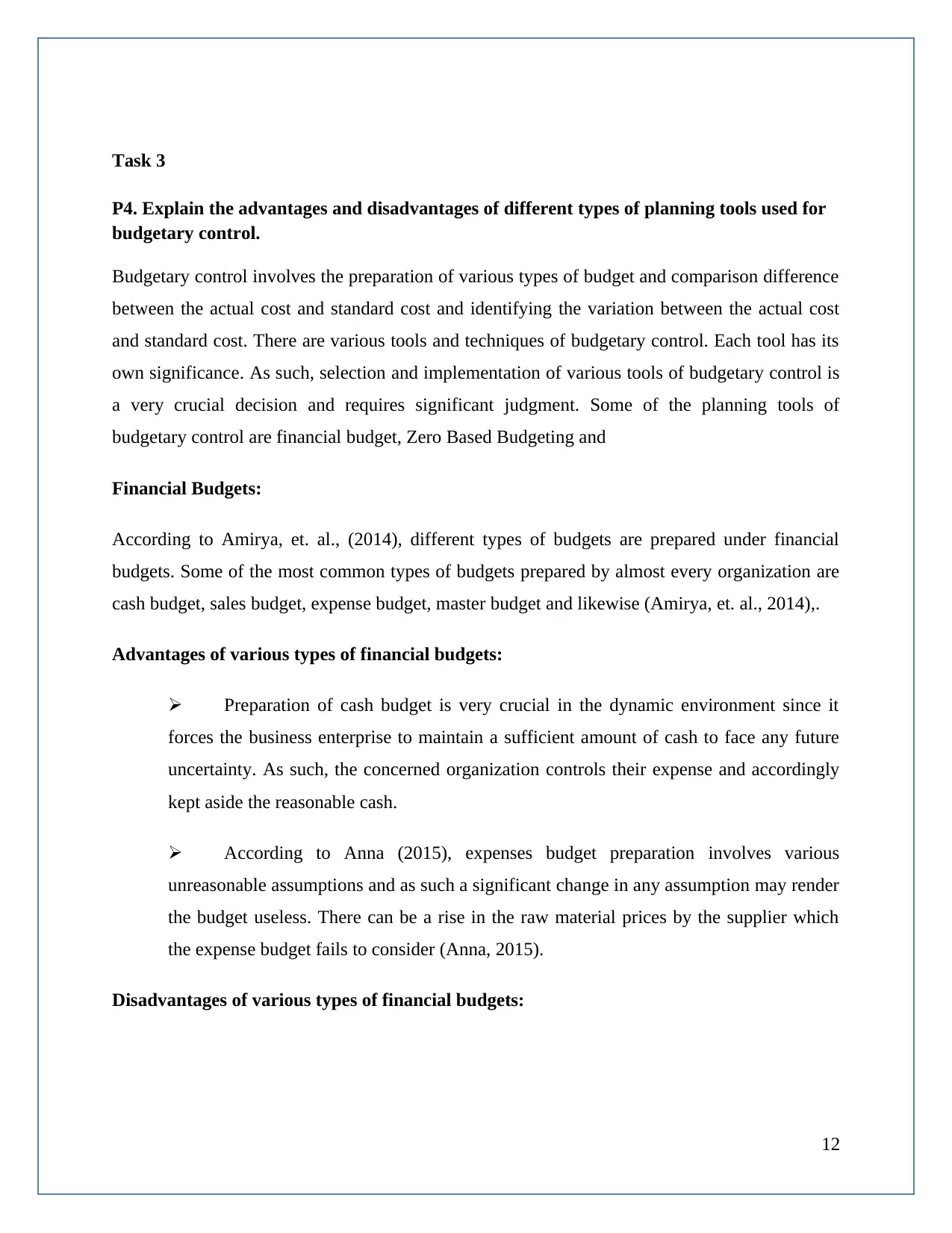
Task 3
P4. Explain the advantages and disadvantages of different types of planning tools used for
budgetary control.
Budgetary control involves the preparation of various types of budget and comparison difference
between the actual cost and standard cost and identifying the variation between the actual cost
and standard cost. There are various tools and techniques of budgetary control. Each tool has its
own significance. As such, selection and implementation of various tools of budgetary control is
a very crucial decision and requires significant judgment. Some of the planning tools of
budgetary control are financial budget, Zero Based Budgeting and
Financial Budgets:
According to Amirya, et. al., (2014), different types of budgets are prepared under financial
budgets. Some of the most common types of budgets prepared by almost every organization are
cash budget, sales budget, expense budget, master budget and likewise (Amirya, et. al., 2014),.
Advantages of various types of financial budgets:
Preparation of cash budget is very crucial in the dynamic environment since it
forces the business enterprise to maintain a sufficient amount of cash to face any future
uncertainty. As such, the concerned organization controls their expense and accordingly
kept aside the reasonable cash.
According to Anna (2015), expenses budget preparation involves various
unreasonable assumptions and as such a significant change in any assumption may render
the budget useless. There can be a rise in the raw material prices by the supplier which
the expense budget fails to consider (Anna, 2015).
Disadvantages of various types of financial budgets:
12
P4. Explain the advantages and disadvantages of different types of planning tools used for
budgetary control.
Budgetary control involves the preparation of various types of budget and comparison difference
between the actual cost and standard cost and identifying the variation between the actual cost
and standard cost. There are various tools and techniques of budgetary control. Each tool has its
own significance. As such, selection and implementation of various tools of budgetary control is
a very crucial decision and requires significant judgment. Some of the planning tools of
budgetary control are financial budget, Zero Based Budgeting and
Financial Budgets:
According to Amirya, et. al., (2014), different types of budgets are prepared under financial
budgets. Some of the most common types of budgets prepared by almost every organization are
cash budget, sales budget, expense budget, master budget and likewise (Amirya, et. al., 2014),.
Advantages of various types of financial budgets:
Preparation of cash budget is very crucial in the dynamic environment since it
forces the business enterprise to maintain a sufficient amount of cash to face any future
uncertainty. As such, the concerned organization controls their expense and accordingly
kept aside the reasonable cash.
According to Anna (2015), expenses budget preparation involves various
unreasonable assumptions and as such a significant change in any assumption may render
the budget useless. There can be a rise in the raw material prices by the supplier which
the expense budget fails to consider (Anna, 2015).
Disadvantages of various types of financial budgets:
12
⊘ This is a preview!⊘
Do you want full access?
Subscribe today to unlock all pages.

Trusted by 1+ million students worldwide
1 out of 23
Related Documents
Your All-in-One AI-Powered Toolkit for Academic Success.
+13062052269
info@desklib.com
Available 24*7 on WhatsApp / Email
![[object Object]](/_next/static/media/star-bottom.7253800d.svg)
Unlock your academic potential
Copyright © 2020–2025 A2Z Services. All Rights Reserved. Developed and managed by ZUCOL.





